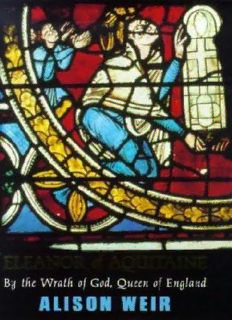
Eleanor of Aquitaine- By the Wrath of God, Queen of England PDF
Preview Eleanor of Aquitaine- By the Wrath of God, Queen of England
Eleanor of Aquitaine Alison Weir This book is dedicated with heartfelt thanks to my agent, JULIAN ALEXANDER and to JILL BLACK who has edited so many of my books. ACKNOWLEDGMENTS I should like to extend very special thanks to my editor, Anthony Whittome, for his creative input and his unflagging enthusiasm for this project, and to my commissioning editor, Will Sulkin, for his tremendous support. Gratitude is also due to Lily Richards for her indefatigable picture research. As always, I must express my thanks to my agent Julian Alexander, without whom this book would not exist: he kept faith with this project for many years before its acceptance. I am grateful also to his former assistant, Kirstan Romano, for all her kindness. Finally, as ever, thank you, Rankin, my husband, and John and Kate, my children, for putting up with me while this book was in preparation. I could never have done it without you. Contents Preface xix Prologue: 18 May 1152 1 1 "Opulent Aquitaine" 3 2 "A Model of Virtue" 21 3 "Counsel of the Devil" 37 4 "To Jerusalem!" 55 5 "A Righteous Annulment" 73 6 "A Happy Issue" 89 7 "All the Business of the Kingdom" 104 8 "Eleanor, by the Grace of God, Queen of England" 120 9 "The King Has Wrought a Miracle" 141 10 "Conjectures Which Grow Day by Day" 158 11 "The Holy Martyr" 177 12 "The Cubs Shall Awake" 189 13 "Beware of Your Wife and Sons" 198 14 "Poor Prisoner" 211 15 "Shame, Shame on a Conquered King!" 231 16 "The Eagle Shall Rejoice in Her Third Nesting" 248 17 "The Admiration of Her Age" 260 18 "The Devil Is Loosed!" 279 19 "The Staff of My Old Age" 300 20 "The Most Reverend Eleanor" 314 21 "The Brood of the Wicked Shall Not Thrive" 326 22 "A Candle Goeth Out" 336 Notes on the Chief Sources 347 Bibliography 355 Notes and References 375 Genealogical Tables 407 Index 423 A Note on Names and Spellings Different variations of the names of people and places occur in twelfth- century sources. For example, the names Matilda, Maud, and Mahalde are interchangeable, as are Alice, Aaliz, and Alais. For the sake of clarity, I have used different spellings of the same name to identify different people. Eleanor's daughter is called Alix, Richard Is betrothed of the same name Alys, and the Lord John's betrothed Alice. All are accurate renderings. A similar differentiation has been used with the name Amaury/Aymer/Aimery. Louis VII's daughter, often called Margaret in other works, is here referred to by the French version of her name, Marguerite. Eleanor, who would have called herself Alienore, is referred to by the more familiar anglicised version of her name. As in many other history books, William the Marshal is throughout referred to as such, even though he did not acquire his office of Marshal until 1199. Although Eleanor was Countess of Poitou and Duchess of Aquitaine, I have occasionally used the name Aquitaine as a blanket term covering both her domains, although I have tried to differentiate between them wherever possible. Many place names have changed since the twelfth century, and where appropriate I have given the modern name in parentheses. Some places no longer exist; wherever possible, I have attempted to discover their exact or approximate location. Illustrations (not included) Palais de Justice, Poitiers © Roger-Viollet William IX, Duke of Aquitaine. Manuscript illumination, fr. 12473 fol. 128 © Bibliotheque Nationale, Paris Louis VII, King of France. Manuscript illumination from "Grands Chroniques de France," fr. 2813 fol. 223 © Bibliotheque Nationale, Paris Rock crystal vase, 12th c, from the Abbey of Saint-Denis, now in the Louvre © Reunion des Musees Nationaux-- Daniel Amaudet Retable of St. Bernard of Clairvaux (detail), anon., 12th c, Museo de Mallorca, on loan from the Sociedad Arqueologica Luliana Count Geoffrey of Anjou. Enamel tombstone, c. 1152, Musee de Tesse, Le Mans © Giraudon Eleanor's seal, from a charter in the Archives de France © Atelier de photographic du Centre historique des Archives nationales, Paris Engaged capital, thought to portray Henry II and Eleanor of Aquitaine. © The Metropolitan Museum of Art, The Cloisters Collection, 1934 (34.115.4ab) Tomb of Matilda, daughter of Henry II, and Henry the Lion, Duke of Saxony, Brunswick Cathedral, late 12th c. © AKG London Effigy of Henry the Young King (detail), late 12th c, Rouen Cathedral © Roger-Viollet Effigy of Henry II (detail), late 12th c, Fontevrault Abbey © AKG London Effigy of Richard I (detail), 1199-1200, Fontevrault Abbey © AKG London Effigy of Berengaria of Navarre (detail), after 1230, Le Mans Cathedral © Geoffrey Wheeler Effigy of King John (detail), c. 1225-1230, Worcester Cathedral © Geoffrey Wheeler Mural from Sainte-Radegonde, Chinon, c. 1196 © By courtesy of Les Amis du Vieux Chinon Effigy of Isabella of Angouleme (detail), mid 13th c, Fontevrault Abbey © Geoffrey Wheeler Effigy of Eleanor of Aquitaine (detail), c. 1204, Fontevrault Abbey © AKG London The tombs of the Plantagenets in the Abbey of Fontevrault © Bildarchiv Foto Marburg Maps The Angevin Empire in 1154 xv Europe and the Holy Land in the Twelfth Century xvi England in the Twelfth Century xviii [map of the Angevin Empire in 1154 removed] [map of Europe and the Holy Land in the Twelfth Century removed] [map of Richard I's route during the Third Crusade, 1190-1194 removed] [map of Eleanor's journey, 1190-1191 removed] [map of England in the Twelfth Century removed]
